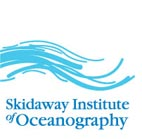Skidaway Institute of Oceanography
 |
|
| Type | Independent Research Unit |
|---|---|
| Established | 1968 |
| Location |
Skidaway Island, Georgia, United States 31°59′19″N 81°01′16″W / 31.988548°N 81.021223°WCoordinates: 31°59′19″N 81°01′16″W / 31.988548°N 81.021223°W |
| Campus | 700 acres (2.8 km2), coastal setting |
| Affiliations | University of Georgia |
| Website | www.skio.uga.edu |
The Skidaway Institute of Oceanography (SkIO) is an internationally renowned marine science research institute located on the northern end of Skidaway Island near Savannah, Georgia, USA. Founded in 1968, it is now a research unit of the University of Georgia. It does not grant degrees, but its faculty serve as adjuncts to universities, and as mentors and advisors for visiting students and interns. SkIO faculty also frequently collaborate with marine scientists of other institutes both nationally and internationally. In 2012, It was announced that SkIO would be put under the management of the University of Georgia as part of an effort to streamline the University System of Georgia, the realignment with the University of Georgia being completed in July 2013.
Skidaway Island was originally a hunting and ceremonial ground of the Timucua Indians. European settlement of the island was successful between 1754 and 1771, and included John Milledge (the father of John Milledge), who established a plantation on the northern end. He named it "Modena," presumably after the Italian city for its famed production of silk. Silk was an early industry of the European settlers of coastal Georgia. The Modena Plantation grew corn, cotton, oranges and mulberry trees, and kept sheep, cattle, hogs and horses. It survived as a plantation into the 1840s, until John Milledge III sold it in 1843. The name "Modena" is still used to refer to the northern part of the island.
After the American Civil War (1861–1865), many of the plantations on the island were unable to continue without slave labor, and their owners gradually sold them to wealthy northerners, who mostly held them on speculation. Much of the island reverted to wilderness and was used mainly for hunting, trapping, fishing and lumber for several decades. The Modena Plantation changed hands sixteen more times after the war. In 1927 the property became a private hunting preserve for Ralph H. Isham, best known for purchasing a collection of James Boswell's private papers from Baron Talbot of Malahide and passing them to Yale University.
...
Wikipedia
